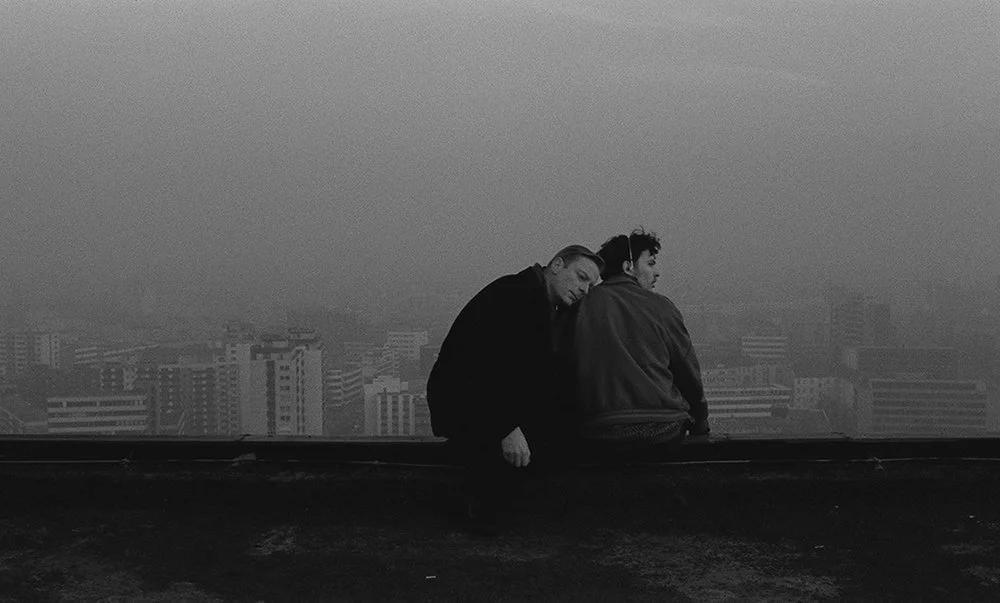Berlin and Wings of Desire
Wim Wenders’ film Wings of Desire is a film that touches on life, death, joy and pain. At its core, it's a film that examines what it means to be human. The main character in the film, an angel named Damiel, grapples with his own immortality and desire for love while observing the lives of humans in 1980’s Berlin. He struggles with the choice between an immortal but unfeeling life as an angel, and a full-spectrum but mortal life as a human; a life unrelenting in its experiences both beautiful and painful. The setting of 1980’s Berlin is a perfect representation of this theme, a city of amazing and terrible extremes. Divided and broken, it was a place full of despair and anger, but also love, beauty, and immense creativity.
Damiel is an angel that has been watching over Berlin, long before the city of Berlin even existed. He and another angel, Cassiel, observe human life in the city, listening to the thoughts, fears, and dreams of its inhabitants. Their goal is to maintain reality while interfering as little as possible with humans. As he observes the daily lives of Berliners, Damiel starts to become discontent with the immortal life of an angel. Though he can see and hear the feelings of humans, he cannot fully experience them himself.
These feelings of dissatisfaction with his angel existence come to a head when he starts observing a trapeze artist, Marion, at a local circus. He is amazed by her resilience and dedication to her craft, and soon falls in love with her. Although she is a skilled performer, she is also very lonely, living by herself in a trailer on the circus grounds. When the circus owner announces the circus is closing, she feels even more isolated and alone. After meeting Peter Falk, a former angel that decided to become mortal to experience human life, Damiel is finally convinced and becomes human so he can be with Marion. He immediately experiences both joy and pain, but is amazed by the opportunity to feel life in its fullest.
The spectrum of emotion felt by humans in the film is perfectly reflected in 1980’s Berlin. Berlin at this time was a place of hardship, full of economic disparity and urban decay. World War II and The Cold War had destroyed much of the infrastructure, and lack of resources meant access to basic needs was often difficult. People lived among the rubble of a conflict that occurred decades prior, while also living among the constant threat of unresolved tension boiling over. The gray, brutalist architecture mixed in with centuries-old gothic structures symbolized current oppression and a past long gone, but never fully forgotten. Pain and hardship are tools that shape us, and the past forms the present.
At the same time, Berlin was also a vibrant hub of art and culture. Throughout the film, the booming creativity of Berliners is on full display; exhibiting visual art through numerous graffiti and murals, film through a working movie set, and the explosive music scene through concerts from Berlin locals The City and Crime Solution and Nick Cave. Children run and play, excited by the brilliance around them. Though there is much evidence of destruction, there are just as many examples of creation and rebuilding. The city portrays the magnificence of the human condition. Hardship is an unavoidable reality, but it makes the beauty that much more beautiful. Berlin is a resounding symbol for the resilience of humanity, and the drive to create and experience joy even in the harshest of settings.
The physical layout of 1980’s Berlin is also a great reflection of the isolation felt by Damien and Marion. The Berlin Wall was the defining feature of Berlin at this time, and is an ever present figure looming in the background of the film. With the Berlin Wall slicing the city in half, East and West Berliners lived in different realities. Just as Damien could only wonder what it must be like to be human, those on one side of the wall could only contemplate the lives of people on the other side. Although there were rare occasions when a lucky few were able to cross the border, it was even rarer that they were ever able to go back to the lives they left behind. Once Damien decides to become human, it is like he is crossing the wall to the other side, and can no longer go back to where he came from. The choice to give up his life as an angel means all he has left with him from his previous life is the knowledge he carries with him.
Wings of Desire is a moving portrait of the significance of humanity and mortality. Life is truly amazing because of the full extent of experiences, good and bad, it has to offer. The setting of late 1980’s Berlin brilliantly encapsulates this significance, and perfectly reflects the human condition.

